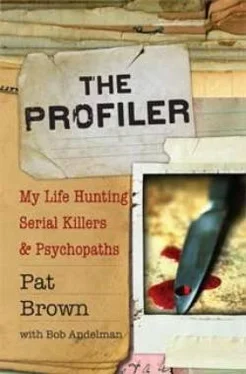Vicki later remembered that her head hit the nightstand by the bed when she went down. She didn’t think it much mattered that she hit her head, because if this wasn’t death, it wouldn’t be long.
The perpetrator threw a blanket over her and walked out, taking with him a few items of little value.
Vicki lay there until she was certain he was gone. Then this remarkable woman, bleeding to death, throat cut, stabbed many times, managed to get up despite the fact that her feet and hands were tied, and she staggered to a telephone. She knocked the receiver off the hook trying to call 911.
Just then, her son-who was pretending to be asleep during the attack-came out and found her. Seeing that her son was safe, Vicki muttered with her last conscious breath, “Go get help!” and passed out. Her terrified boy ran next door, banged and screamed until the residents came to the door and called 911. Emergency medical technicians came and Vicki miraculously survived.
It’s just mind-boggling. The damage that was done was seemingly beyond repair. It still amazes me, and Vicki, that she survived one of the most horrific attacks imaginable.
It seemed like one victim was going to see justice. She lived to be able to identify her attacker.
One month after the crime, Painter was arrested. On October 1, 1995, a neighbor called to report a suspicious person in Vicki’s yard. He was sitting in a red pickup truck near Vicki’s home. The arresting officer noted that not only did the driver match the description of the suspect but the composite drawing the police sketch artist did was actually taped to the windshield of his truck! Painter told the officer that he had been visiting his daughter, who lived in the same trailer park, and had just left Vicki’s trailer, where he had said a prayer for her. He was photographed, interviewed, and released.
The next day, Vicki picked Painter out of a lineup of six photos and said the man in the picture was the man who broke into her home, sexually assaulted her, and stabbed her.
He was arrested again four days later when Vicki’s son independently identified Painter from the six photographs he was shown.
“He seems to have some kind of thing going on in his brain that he thinks he is God,” Vicki later said of Painter. “He told the police that he felt strange vibes that told him to go to my house and burn a candle and pray for me right after the attack. When the police finally arrested him, they told me that during the entire ride to the courthouse, he was chanting.”
Painter said he was in the area at the time of the attack on Vicki, visiting a former wife and stepdaughter who lived in the same mobile home park.
That should have been the end of the investigation.
But in reality, the victim survived and the case died in the hands of the criminal justice system. Vicki knew something was wrong early in the investigation when the police seemed determined to keep the crime out of the headlines.
“They did such a good job of keeping quiet that it really pissed me off,” she wrote to me in an e-mail. “I didn’t realize what they were doing until it was too late. The detective actually pretended to cry because he knew I was a caring person [and] he led me out through the back of the courthouse to be sure that I didn’t talk to reporters. He also told me not to talk to any of the TV stations that were calling me. Stupid!! I was so caught up in making sure that everything was done right and that I would not mess up anything that I believed all the crap they fed me along with it. I wish I could have done things a whole lot different. I would have walked out of the court and screamed at the top of my lungs to all the reporters that the system is shit.
“I had seen on TV that the victim is allowed to help with her own case. When I asked the detectives about that, they said, ‘No way.’ I’m sure that they are so busy that they are either overlooking and missing a lot of good info, or they just don’t want me to know the real story about how much they have misplaced. I gave them everything, I made sure that I was writing notes while I was in ICU, giving them all the details. They were very accurate. How could they not be able to use it?”
The Delaware grand jury decided that the state had enough evidence against Painter and handed down an indictment charging him with first-degree attempted murder, burglary, kidnapping, first-degree unlawful sexual contact, and possession of a deadly weapon during the commission of a felony.
Painter pleaded not guilty.
The case was continued several times as prosecutors waited for the FBI to complete its DNA tests on evidence. Meanwhile, Painter underwent a psychiatric exam in which he said he did not know where he was or what he was doing on September 18 or 19, 1995. A doctor diagnosed Painter with “undifferentiated schizophrenia” but declared him competent to stand trial.
“I find no reason to believe that he would not have been responsible at the time of the crimes,” she wrote.
Two days before the attempted murder trial was scheduled to finally begin in Delaware, Vicki Davis was notified that Painter would be released and would not be going to trial for attempting to kill her.
“I called in and I demanded that the detectives explain how he could have done this to me and not left any hair or fibers,” Vicki wrote to me. “I was so confused… I wish I had thought to say at the time, ‘Did you guys just screw up?’ But I was protecting the detective that had told me confidentially that the evidence was lost.”
PAINTER ALSO BECAME a suspect in the 1995 murder of Lisa Young.
Lisa was a seventeen-year-old living in a state near the nation’s capital. A junior in high school, she left her after-school job at closing time and sat outside on a brick flower box with two bags of clothes she had purchased earlier and a soft drink, waiting for friends to pick her up. Then she just vanished. There were reports that she possibly got into a maroon or burgundy car, leaving her belongings on the sidewalk.
The next day at 5:30 a.m., a passing motorist found her fully clothed body about a mile down the road. She had been strangled, her head scored with knife wounds, and her throat cut. Her jewelry was stolen.
Painter became a suspect in the homicide investigation because he had a car that was similar to the one that allegedly took Lisa away, and he was in the area at the time. He was in jail awaiting trial in a nearby state, and this homicide looked awfully similar to the assault six months earlier of Lisa Young (though that case was ultimately dropped). The detective working the Young case decided to pay Painter a visit in jail.
The detective interviewed Painter and found that just prior to his arrest, Painter had disposed of his late model, burgundy car-had it crushed, actually-because, he said, “It had a bad smell in it.”
There was white dog hair from a boxer found on Lisa’s body. According to neighbors, Painter got rid of his dogs right before a detective showed up to question him.
It seemed like another easy case to close. “This is the guy,” the detective said.
Lisa’s mother, Jessie Young, called me in January 2000. She wanted my help investigating her daughter’s 1995 murder, but asked that we keep it quiet for four months, until after the fifth anniversary of the crime passed. She said she had not seen the autopsy report-nor did she care to-and she didn’t want me to see it, either. She wanted to keep the details of her daughter’s death private.
PAINTER, EVEN IF he wasn’t responsible for the attacks on Vicki and Lisa, certainly seems to have anger-retaliatory issues with women.
My take on him is that he views women as the cause of his problems and may have sought to regain his lost power through assaults on females. Painter certainly exhibited anger and violence five years earlier when he assaulted a girlfriend who told him she was leaving him. He was arrested but got only one hundred days of community service working in a food bank.
Читать дальше












